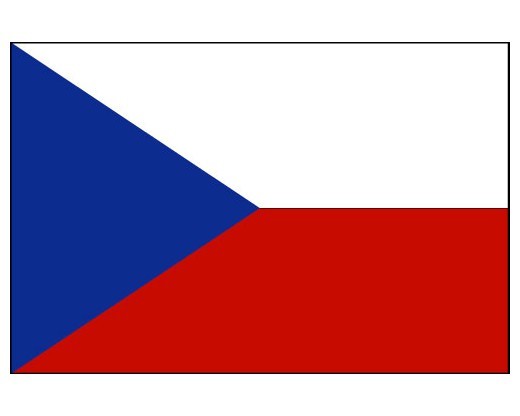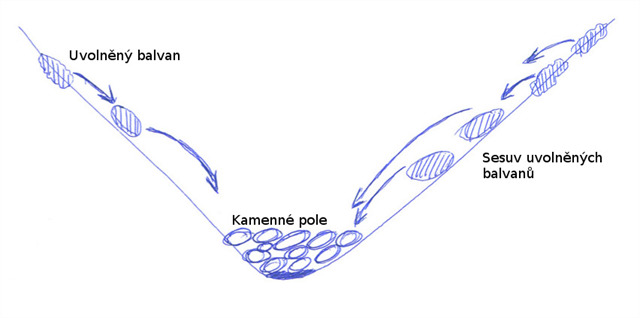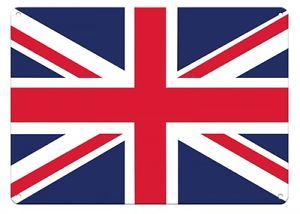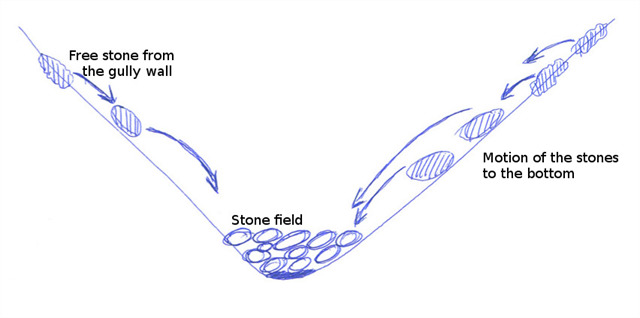
Vlčí rokle
Vlčí rokle je přírodní památka nacházející se v katastru obce Krhanice v blízkosti lomů na granodiorit požárského typu a tonalit sázavského typu. Vznikla erozí, konrétně zařezáváním se Vlčího potoka, pravého přítoku Sázavy. Stěny rokle jsou porostlé až 200 let starými bučinami a dno rokle je vyplněno kamennými poli z balvanů granodioritu, která vznikla v důsledku akvatické eroze stěn rokle. Stěny rokle se rozpadaly a vzniklé balvany se sunuly na dno. Jednou ze zajímavostí je, že oblast je velmi chudá na flóru a na stěnách rokle nenajdeme skoro žádná křoviska, byliny apod. Je to z toho důvodu, že rozpadem granodioritu vzniká chůdá písčitá půda. Roklí prochází žlutá turistická stezka vedoucí od vlakové zastávky v Prosečnici do Nechánic. Pokud se vydáte z Prosečnice po žluté, můžete kousek před rozcestníkem Horní Požáry odbočit doprava na červenou turistickou trasu a vrátit se zpět na zastávku v Prosečnici. Celý okruh měří necelých 5 km.

Schematický náčrt vzniku kamenných polí.
Granodiorit
Jak již bylo zmíněno, kamenná pole jsou tvořená balvany granodioritu. Granodiorit je hlubinná vyvřelá hornina s podstatným množstvím křemene. Bývá obvykle šedé barvy s rovnoměrně zrnitou strukturou. Je blízký žule a diority, od kterých je makroskopicky těžko rozeznatelný a tvořý jakýsi přechod mezi těmito dvěma horninami. Označení zavedl v roce 1893 americký geolog G. F. Becker jako kombinaci názvů granit (žula) a diorit. Místní horniny vznikly během variského vrásnění v období karbonu.
Granodiorit obsahuje v podstatném množství křemen, plagioklas i draselný živec, přičemž plagioklas nad draselným živcem převládá. Z dalších minerálů bývá často přítomen biotit a amfibol. Muskovit bývá přítomný pouze vzácně, a pokud ano, tak je vždy doprovázen biotitem. S turmalínem se u granodioritů, na rozdíl od žul nesetkáme.
Granodiority mnohdy tvoří rozsáhlá tělesa. Spolu s žulami jsou nejrozšířenějšími hlubinnými vyvřelými horninami. U nás se vyskytuje hojně např. ve středočeském nebo brněnském plutonu. Granodiorit je těžen a zpracováván v kamenickém průmyslu. Vyrábí se z něho např. dekorační obklady, různé obrubníky a dlažba. Na obrázku níže můžete vidět podobnost mezi žulou, granodioritem a dioritem.

Jak na keš?
Úvodní souřadnice vedou do blízkosti jednoho z kamenných polí. Pokud jdete zeshora je to jedno z prvních, na které narazíte. Souřadnice jsou orientační, neb GPS v rokli dost hapruje. Abyste mohli logovat pošlete mi zprávou odpovědi na následující úkoly:
Povinné úkoly:
1) Popište vlastními slovy tvar, typickou velikost a zbarvení balvanů v kamenných polích na dně rokle.
2) Kde se nacházejí větší balvany? V kamenných polích na dně rokle v její vyšší nebo nižší části?
3) Můžete v balvanech na dně rokle nalézt prvohorní fosilie?
Nepovinný úkol:
Přiložte k logu fotografii sebe nebo své gps před jakýmkoliv kamenným polem na dně rokle.
Po zodpovězení otázek můžete rovnou logovat - v případě nejasností se ozvu. Pokud se neozvu, berte to jako souhlas s Vašimi odpověďmi.

Wolf gully
Wolf gully is natural protected area located close to villages Krhanice and Prosečnice in Central Bohemia. There are mines of Požáry type granodiorite and Sazava type tonalite close to the area. This gully was formed by the small creek and its cutting through the ground. Walls of the gully are full of 200 years old beech trees and the bottom is full of stone fields from granodiorite stones. These granodiorite stone fields were formed also by the erosion. Walls of the gully decayed to particular stones which went down to the bottom of the gully. One interesting thing is that there are lack of other plants like herbs and bushes. It is because the soil is composed mainly by the granodiorite sand. There is yellow hiking path through the gully. If you follow this yelow route from Prosečnice, you can turn right on red route close to the Horní Požáry crossing and continue back to the train stop in Prosečnice. This routing is around 5 km long.

Schematic drawing of the stone fields creation
Granodiorite
Granodiorite is magmatic rock with significant content of quartz. It has usually grey-ish colour with grain structure. It is very similarto granite and diorite from which is hardly distinguishable. It could be said that from the geological point of vew the granodiorite is between the two previously mentioned rocks. The name granodiorite was established by US geologist G. F. Becker in 1893. Local rocks were formed during Variscan orogeny in Carboniferous period.
Granodiorite contains mainly quartz, plagioclase, and potassium feldspar. From other minerals there can be biotite and amphibole, rarely muscovite. Comparing to granite there is no content of tourmaline in granodiorit.
Granodiorites with granites are the most common magmatic rocks creating big layers in Earth's crust. In terms of the Czech Republic it is common in central Bohemia or southern Moravia. It is processed in stone industry and used for maing pavements, tiles etc. You can see the similarity between granite, granodiorite and diorite in figure below.

About the earthcache
Initial coordinates point to the Wolf gully near to one stone field. There are many stone fields in the gully. These coordinates are just as the initial point because GPS does not work correctly in the gully. To log this earthcache you must send me answers on following tasks:
Mandatory tasks:
1) Describe by yourself typical shape, size and colour of the stones within stone fields in the bottom of the gully.
2) Where are bigger stones - within stone fields in higher or lower part of the gully?
3) Can you find Carboniferous fossils in these stones?
Optional task:
Attach a picture of yourself or your GPS in front of any stone field in the bottom of the gully.
You can log directly after sending the answers. If there is something wrong I will contact you.